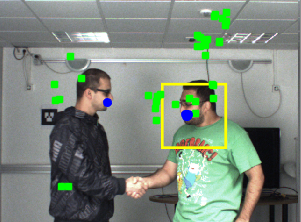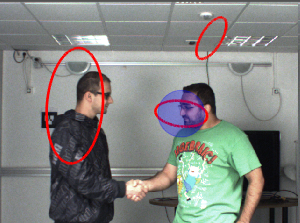Section:
New Results
EM for Weighted-Data Clustering
Figure
5. We developed a novel multimodal clustering method that is based on expectation-maximization (EM) with weighted data. The left image shows auditory features (green), namely sound source positions mapped onto the image plane using [24] and visual features (blue, lip landmarks), as well as the active speaker (yellow square). The right image shows the results of our weighted-data EM algorithm that finds three clusters. Among these clusters, the active audio-visual cluster is marked with a transparent blue circle.
|
|
Data clustering has received a lot of attention and many methods, algorithms and software packages are currently available. Among these techniques, parametric finite-mixture models play a central role due to their interesting mathematical properties and to the existence of maximum-likelihood estimators based on expectation-maximization (EM). In this paper we propose a new mixture model that associates a weight with each observed data point. We introduce a Gaussian mixture with weighted data and we derive two EM algorithms [29] : the first one considers the weight of each observed datum to be fixed, while the second one treats each weight as a hidden variable drawn from a gamma distribution. We provide a general-purpose scheme for weight initialization and we thoroughly validate the proposed algorithms by comparing them with several parametric and non-parametric clustering techniques. We demonstrate the utility of our method for clustering heterogeneous data, namely data gathered with different sensorial modalities, e.g., audio and vision.
Website: https://team.inria.fr/perception/research/wdgmm/



